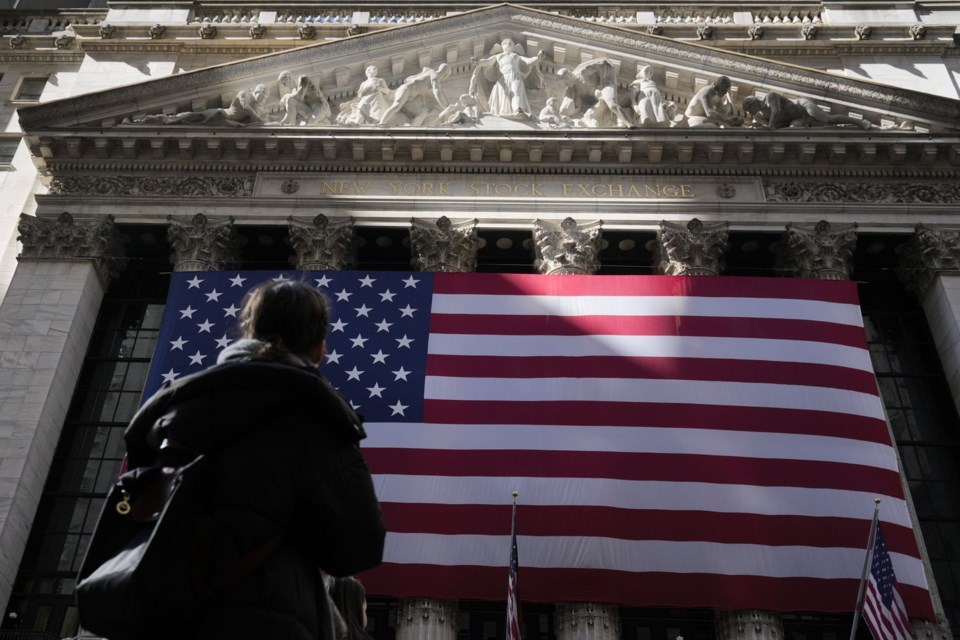NEW YORK (AP) — U.S. stock indexes fell sharply as Wall Street’s frenzy around artificial-intelligence technology faltered some more. The S&P 500 sank 1.6% Thursday for its fifth drop in six days after setting an all-time high last week. Concerns about the U.S. economy’s future have been behind much of the drop, including worries about President Donald Trump’s tariffs, and the index has lost all but 1.4% of its rally since Election Day. The Dow Jones Industrial Average fell 0.4%, and the Nasdaq composite tumbled 2.8%. Nvidia and other high-momentum AI stocks weighed heavily on the market Thursday as Wall Street’s biggest stars keep dimming.
THIS IS A BREAKING NEWS UPDATE. AP’s earlier story follows below.
NEW YORK (AP) — U.S. stock indexes are slumping Thursday as Wall Street's frenzy around technology falters some more.
The S&P 500 was down 1.3% in late trading and on track for its in six days after setting an . Concerns about have been behind much of the weakness, including worries about how pushed by could worsen , and Wall Street's main measure of health has lost all but 1.7% of its rally since Election Day.
The Dow Jones Industrial Average was down 146 points, or 0.3%, with less than an hour remaining in trading, and the Nasdaq composite was 2.2% lower.
Weighing most heavily on the S&P 500 was superstar stock , one of Wall Street's most influential companies that has been leading the market for years. After initially rising at the open of trading following a , Nvidia quickly slid to a loss of 7.1%.
Better-than-expected earnings reports have become routine for Nvidia, whose chips are powering the surge into technology, but this was the company's first since shook the .
After the Chinese upstart said it developed a large language model that can compete with the world’s best without using the most expensive chips, Wall Street had to question all the spending it assumed would go into Nvidia’s chips and the ecosystem that’s built around the AI boom, such as electricity to power large data centers.
Nvidia’s performance for the latest quarter, along with its forecasts for upcoming results, were “good enough to keep the debate moving in a positive direction,” according to analysts at UBS led by Timothy Arcuri.
But it apparently wasn't enough to send Nvidia's stock higher, particularly given criticism that its price had already leaped too high, too quickly. After more than tripling two years ago, it more than doubled last year as its sales exploded.
The market also soured on Salesforce, which fell 3.8% despite topping analysts’ profit expectations for the latest quarter. Several analysts called the performance solid, and the company continued to tout its AI offerings, but it gave forecasts for upcoming revenue that fell short of expectations.
One AI-related company bucking the trend was Snowflake. The AI data cloud company rose 5.7% after delivering stronger profit and revenue for the latest quarter than analysts expected.
It joined a range of stocks on the more staid end of Wall Street, ones that didn't grab as many headlines as AI-related companies in recent years. Despite the sharp loss for the overall S&P 500, roughly 2 out of every 5 stocks in the index rose.
A 1.7% rise for Berkshire Hathaway, the company run by famed investor Warren Buffett, was one of the strongest upward forces on the index. The owner of Geico, BNSF railroad and other businesses has built recently. The could indicate Buffett, who’s famous for buying stocks when prices are low, may not see much worth purchasing in a market that critics say looks too expensive.
Gains of 1.1% for Visa and 1.5% for UnitedHealth Group also pushed upward on the market.
Some investors have been waiting for other stocks to pick up the market's leadership baton from Nvidia and a handful of high-momentum companies that had dominated for years. Nvidia alone accounted for a little more than 22% of the entire total return for the S&P 500 index last year.
In the bond market, Treasury yields swung up and down following Trump’s latest announcement on . He said “the proposed TARIFFS scheduled to go into effect on MARCH FOURTH will, indeed, go into effect, as scheduled” for imports from Canada and Mexico. He also said he would add an additional 10% tariff on Chinese products on that date.
Such tariffs could push up prices for U.S. households when inflation has already proven to be stubborn to ease. Wall Street has been hoping such threats are merely leverage that Trump will use in negotiations with other countries before ultimately inflicting less pain on the economy than feared.
But even if that were the case, all the talk on tariffs has already gotten about the economy. That’s dangerous if it causes them to pull back on their spending, which has been strong enough to keep the U.S. economy out of a recession.
They're also pressuring the Federal Reserve, which has few if any tools to help an economy when growth is slowing and inflation is rising at the same time.
Jeff Schmid, president of the Federal Reserve Bank of Kansas City, said in a speech Thursday that he has "become more cautious" in his hopes that inflation will continue to ease. He also said that discussions with people in his district suggest “elevated uncertainty might weigh on growth” for the economy.
For now, at least, the U.S. economy appears to be in solid shape. The government on Thursday left alone its estimate for how the , though it raised its estimate for a measure of inflation during the quarter.
A separate report said benefits last week. While the number is at a three-month high, it is still nowhere close to where it’s been in past recessions.
The yield on the 10-year Treasury rose to 4.28% from 4.26% late Wednesday.
In stock markets abroad, indexes were mixed across Europe and Asia. Germany’s DAX lost 1.1%, while Japan’s Nikkei 225 added 0.3%.
___
AP Business Writers Matt Ott and Elaine Kurtenbach contributed.
Stan Choe, The Associated Press




